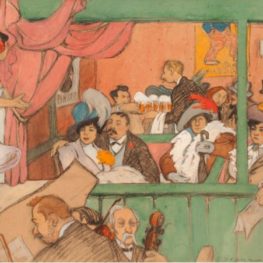Maude Squire
1873-1954
Born in Cincinnati, Maud Squire studied at the Cincinnati Art Academy and worked briefly in Chicago. For several years around the turn of the century, she and her lifelong companion Ethel Mars shared a studio in New York and collaborated on a number of children’s books. The Cincinnati Art Museum gave a joint exhibition of their works in 1904. By 1907, they had settled in Paris, where they would remain until the outbreak of World War I. They were part of Gertrude Stein’s circle and were profiled by Stein in one of her word portraits, “Miss Furr and Miss Skeene.” Similarly to Stein and her partner Alice B. Toklas, Squire and Mars were were noted for their unconventional lifestyle as well as their, at times, unconventional style of dress. Their friendship may be hinted at in this work, for the figure holding a parasol and wearing a large red feather in her hat may be Gertrude Stein herself.
While in Paris, Squire was undoubtedly influenced by the avant garde art and artists of Paris. She was a member of the Société Salon d’Automne and the Société des Dessinateurs et d’Humoristes and was a frequent exhibitor. She favored watercolors, chalks, and color intaglio prints, with scenes of daily life, including café scenes, particularly around 1912 and 1913. They both successfully made their living in France, although Squire may also have had a trust fund from her parents’ inheritance. They knew and associated with other American expatriate artists. Squire also worked in commercial illustration.
The two artists returned to the United States around 1915 and settled in Provincetown. They were soon an active part of the artists’ colony, spending that first winter in Provincetown with Ada Gilmore, B.J.O. Nordfeldt, Mildred McMillen, and Juliette Nichols, developing what became known as the Provincetown printmaking style, a unique printing technique of white-line woodblocks. Their international reputation also helped draw other artists to Provincetown who championed this style. Squire continued to exhibit during this period, at the Art Institute of Chicago, the Panama-Pacific Exposition in 1915 (21 works), the Society of Independent Artists, the Provincetown Art Association, the Pennsylvania Academy of the Fine Arts, and the Boston Arts Club.
Squire and Mars returned to France in 1920 and by 1925 had relocated to Vence, in the south of France, also a popular destination for artists. Fellow artists in Vence include Ada Gilmore, Marsden Hartley, Reginald Marsh, Jules Pascin, and Chaim Soutine. By 1928 they had built a villa, La Farigoule, in Vence, but they had to flee with the advent of World War II and retreated to a hotel in Goncelin, Isere, France. Squire had mostly ceased her artistic output by this time, other than drawings in notebooks. She died at La Farigoule in 1954. She and Mars had lived together for 50 years; they are buried together in Vence.
Her works were acquired by the Detroit Institute of Art, the Herron Gallery at Purdue University, the Library of Congress, the Smithsonian American Art Museum, the Boston Museum of Fine Arts, as well as private collections.

